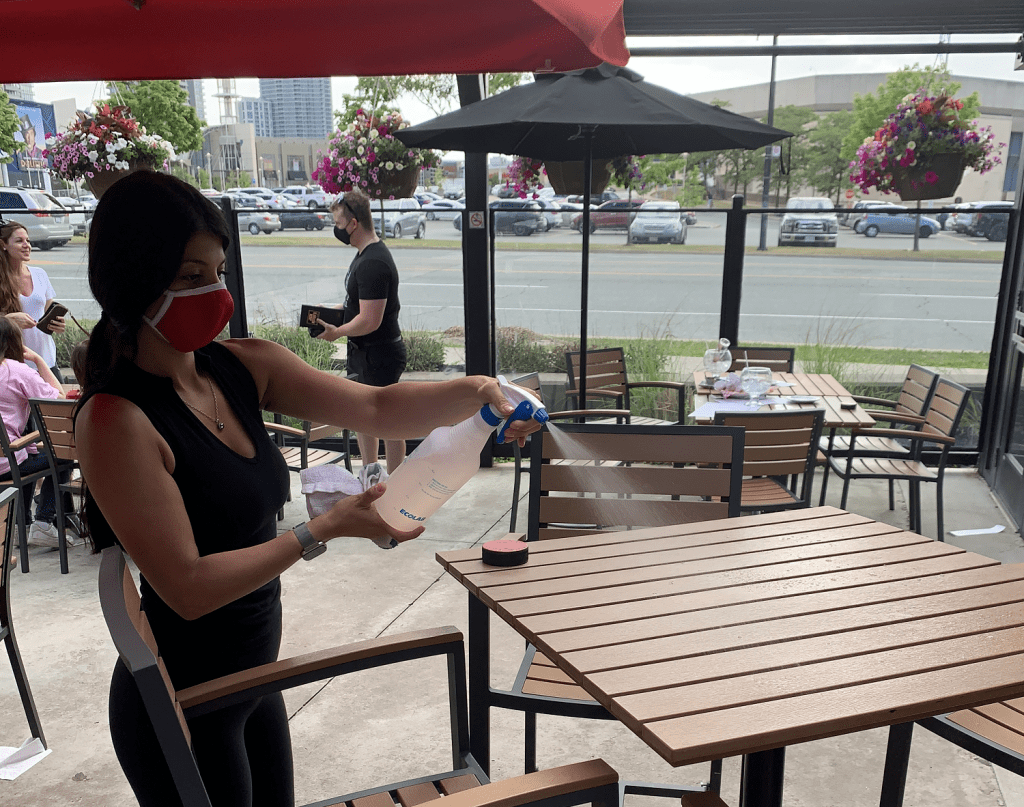Winter is Coming: Looking at the last six months to prepare for months ahead
“Winter is coming…and we know what comes with it” is one of the most well-known phrases in modern popular culture. And for the current state of Canada’s restaurant industry, truer words have never been spoken.
Well, almost true.
While we do know that the fall/winter months equal slower traffic and leaner revenue, that’s the only thing that’s for certain. Will restaurants continue to receive the desperately-needed government support they’ve had during the lockdown? Will the COVID-19 pandemic restrictions continue to relax…or could a second wave arise and send us into another lockdown.
Restaurants have been pivoting, adapting and displaying remarkable agility through the last six months to tread water, but with the most profitable months of the year behind us, the goal is not to thrive right now—it’s to survive.
“Nobody truly does know what the future is going to look like, and if anybody says they do…RUN,” says Jo-Ann McArthur, president and chief strategist at Nourish Food Marketing. “We’re at a time when consumers are feeling more comfortable than they were at the start of the pandemic, but that could quickly change if we get a second wave.”
McArthur, like the rest of the foodservice industry, has been riding the financial and emotional roller coaster that has been the past few months. It’s a time when restaurants have been making the best with what they have, but they’re playing against a stacked deck.
First, there was the COVID-19 lockdown, where restaurants were limited to just takeout and delivery, but consumers were overwhelmingly scared to venture out. Then restaurants were allowed to offer limited patio space, and eventually our current climate of indoor dining at a reduced (50 per cent) capacity.
Even though the restrictions have gradually eased, and customer confidence slowly grew, there’s still a lot of the market unavailable: McArthur explained that IMI research for Canada showed that one-quarter of Canadians will not have an indoor restaurant dining experience until a vaccine has been developed.
Why is there still such a hesitancy from consumers to support the restaurant industry? For Larry Isaacs, president of the Firkin Group of Pubs, it starts with the messaging from the top.

“The government is still telling people to stay home, to stay indoors,” says Isaacs. “That means there’s still nobody going to work in their offices, so lunchtime business rushes, cocktail hours and after-work parties are all no longer a thing for restaurants.”
Isaacs explained that restaurants typically operate at razor-thin three-to-four percent margins at standard full capacity. The patios and warm weather have been a help, but once those are taken down restaurants will only be left with the 50 per cent capacity dine-in seating, which truly isn’t even that much: when factoring in the physical distancing guidelines and precautions, Isaacs estimates that most restaurants will run at about a 25-30 per cent capacity.
“That, along with takeout and delivery, is simply not a sustainable business model,” says Isaacs.
Getting in the best position to survive
While the industry as a whole suffered massive losses throughout the pandemic, some restaurants were able to do better than others, because of a few key adaptations.
For David Hopkins, president of The Fifteen Group, two major things stood out. The first was planning: restaurants that exceeded expectations sat down and thought about how to get through this ‘new normal,’ even if it was just the short term.
“Restaurants
that just opened their doors, with the same menu, same price point—same
everything—they haven’t been as successful,” says Hopkins. “They were in for a
surprise as what worked for them six months ago probably didn’t work in this
environment.”

That planning could have ranged from simply adjusting hours to completely overhauling their restaurant offerings and business concept, all to suit customer needs.
Service Inspired Restaurants (SIR Corp.), which owns 60 different restaurants under a number of different themes and banners (predominantly in Ontario), realized this need to pivot quickly and adjust to this new reality.
“We started as a very busy place for social dining occasions, and had to pivot into a glorified takeout business,” says Anesie Johnson-Smith, vice president of marketing for Service Inspired Restaurants. “We started offering items in a way that we became a grocery store, then we offered a liquor store; it was almost a weekly change that we started to implement based on adapting and adjusting to what we saw happening in the marketplace.”
Johnson-Smith added that they severely cut down their menus at all their various locations, while constantly doing temporary additions (and deletions) based on what services they could offer.
For SIR Corp’s Scaddabush locations, one of their key products is fresh mozzarella, which “did not travel well, no matter how many different types of packaging they tried.” That led them to remove it from their offerings, but it was returned as soon as some form of dine-in service was restored.
Other restaurants, such as The Birds & The Beets in Vancouver, decided to essentially reinvent themselves.
Owner
Matthew Senecal-Junkeer says that they operated two different locations,
choosing to temporarily close one down at the beginning of the pandemic and
converting the other one from a cafe/bakery to a grocery-style takeout service.

“We’re a bakery, so we sold baked breads and made jams, yogurts, that sort of stuff,” says Senecal-Junkeer. “Normally we’re making consumed-on-site sandwiches and such, so we shifted our focus pretty dramatically, while also reducing our hours and staffing quite dramatically as well.”
While going from a full lockdown to relaxed restrictions didn’t make everything better, Senecal-Junkeer noted that they are currently down 30 per cent year-over-year, but they started down 70 per cent in May (heading into June).
“Every month has been 20-25 per cent busier than the month before it, so we’re definitely seeing a positive trend,” says Senecal-Junkeer. “We were a takeout sandwich restaurant, but now we’re a bakery/grocery that also serves sandwiches too.”
Safety is paramount
The other major standout for Hopkins was that restaurants that took a more professional and disciplined approach to health and safety have fared best.
“We always say that the most important pillars of restaurant success are quality, service and atmosphere,” says Hopkins. “But now there are four pillars: quality, service, atmosphere and cleanliness/sanitization.”
Hopkins noted that it starts from the very beginning: what’s the messaging on your social media? Your website? How do you answer when people ask about your protocols?
He stressed that from the get-go, you need to convey a real level of professionalism, which the majority of restaurants took to heart.
“One of the
biggest things we had to focus on was communication and transparency with our
guests and our people,” says Johnson-Smith. “We had mandatory PPEs for our team
members. Mandatory health screening checks every day for all our staff—before
they even entered the building.”

SIR Corp also introduced strict hand-washing and sanitizing protocols: any touchpoint or guest surface was constantly sanitized and they had to remove tables and change the configuration of both their dine-in space and patios to adhere to physical distancing.
“The one thing we learned the most was that safety became the cost of entry…in any kind of visit,” says Johnson-Smith. “We had to pivot from being foodservice experts into becoming safety experts.”
It was a lofty, and costly, undertaking that all restaurants had to take, but it was essential in being transparent with customers that they put their safety above all else.
While a new-found emphasis on advanced cleaning sounds like more work for everyone, McArthur notes that it presents a new opportunity to leverage technology to provide the customer with a new—but still seamless—experience.
“Make sure that you’re preparing guests for your experience before they even come to your restaurant,” says McArthur. “Ensure that they know what your safety protocols are. Let them look at the menu before they arrive, perhaps even allow them to order in advance.
“That’s already existing consumer behaviour: most customers check out a menu online before they actually go to a restaurant. So leverage that behaviour and have people actually decide what they want to eat beforehand. It makes it easier to prepare for the back-of-house, easier for food inputs and promotes less food wastage.”
It also provides much-needed transparency. McArthur recommends restaurants “show people you’re cleaning—make it a hygiene theatre.”
With the ease of how a negative story can spread, it’s also critical that restaurants handle their health and safety protocols in an authentic way.
“We just did a really good job of following the rules in good faith, and not trying to find little loopholes to beat the system,” says Senecal-Junkeer. “Consumers sense when places are cheating or trying to bend the rules, so we’re all better served by everybody universally following those guidelines in good faith—and it seems to be working.”
The challenges ahead
Despite coming so far, there is still so much uncertainty ahead that restaurants need to remain nimble and ready for anything, and more cost-saving measures may need to be put in place.
“Restaurants have already narrowed menu selection, but they realistically will have to look at increasing prices,” says McArthur. “The cost of doing business has gone up: labour is your No. 1 input, food costs are going up across the board, along with the additional safety protocols and only running at half capacity: don’t try to hide the fact that it costs more to do business.”
While a price increase may be immediately off-putting, Hopkins notes that it’s not actually as bad as you think: For perspective, roughly a 30 per cent sales reduction, due to lack of volume, can be offset by about a 12 per cent price increase.
“Restaurants
are really going to have to look at their pricing and profitability model and
really figure out what they need to do to make it through the winter,” says
Hopkins.

At SIR Corp, while all avenues are being explored, they’re finding that the best approach is to simply give the customer what they want…and more.
They noticed that consumers started to change their ordering habits, and their menu mix changed pretty severely from pre-COVID to post-COVID as people gravitated towards classic favorites.
“At Jack Astor’s, chicken fingers were always our No. 1, but it grew to about 30 per cent of our menu mix,” says Johnson-Smith. “People were craving those familiar, comfort foods that they trusted, so we started innovating around chicken fingers again, and we added around eight new flavours of chicken fingers this summer.
“We decided that hey, if guests really wanted something, we were going to give them the best possible experience in that product.”
For The Birds & The Beets, they’re back to about 60 per cent of their full menu right now (and both locations are open again). But as they make most of their products in-house and from scratch, with a reduced seating capacity, Senecal-Junkeer realized that committing to the whole menu was not in their best interest if he wanted to maintain giving a high-caliber guest experience.
What he has done, innovation-wise, is add new capacities, such as a pizza oven, to create food that is conducive to take out. He’s hedging his bets on a second wave hitting, in a sense, by having offerings that should work really well if that event does occur—or even if it doesn’t.
Can’t do it alone
While restaurants have displayed remarkable dexterity in navigating through this dark and uncertain period, it’s becoming increasingly obvious that they won’t be able to manage through the coming months alone.
The government has provided both rent and wage subsidies to the majority of restaurants (with 70-85 per cent of staff wages subsidized for qualifying restaurants), but those subsidies are set to expire in December—even after being extended.
Isaacs has
been one of the champions and faces of lobbying for an even further extension,
and possibly increasing, the amount of government support, because it still
simply isn’t enough.

“The restaurant industry holds 1.2-million employees, in which 800,000 of them are without work right now,” says Isaacs. “The assistance from the government, in both wage subsidy and rent relief, is necessary for all restaurants to survive.”
He maintains that the combination of the subsidies expiring, when restaurants are hitting their leanest fiscal stretch and the continued cautiousness being pushed by the government is a one-two punch that will KO a lot of restaurants.
“Our business is a social industry, and to be able to allow only a few people to come in—and be separated—it hurts our restaurants,” says Isaacs. “The ambiance is critical to our product, and if this messaging continues, then Christmas parties and holiday parties, normally big draws for all restaurants, will not be a part of our revenue this winter.”
Johnson-Smith noted that the restaurant industry is made up of incredibly hard-working, resilient and talented people, who are willing and ready to fight to stay alive, but there’s a somber reality.
“Without government support, this will not be possible,” says Johnson-Smith. “As a cornerstone of our country’s economy and social fabric, we need to protect our restaurant industry so that we can continue to safely employ and serve millions of Canadians.”
More options to ensure survival
While Jo-Ann McArthur, president and chief strategist at Nourish Food Marketing, understands that nobody has the playbook for how to best stay afloat heading into the coming months, she does have some ideas for restaurants to explore adoption to help their bottom lines.
Utilizing QR Codes:
OpenTable and some of those reservation services are starting to add pre-dining features and expanded technology, but the good-old QR code is still relevant. Every phone now has a built-in QR reader—use them.
Dedicated reservations:
These may need to make a comeback. With limited capacity, restaurants need to make every table profitable, so it may be a situation where customers have to pay for not showing up on a reservation. But it’s something that will be tough to manage in this climate, because say, for instance, someone cancels a reservation because they are feeling sick?
Dynamic pricing:
Airline and sporting events have been doing it for decades, but that’s potentially an opportunity for restaurants as well. It’s a chance to smooth out those traffic spikes and stay busier throughout the day. Perhaps we need to look at the concept of an early-bird special or happy hour put throughout the day. It not only helps the front-of-house, but it helps keep the kitchen from getting slammed and it could go a long way to promote staff and customer safety as well.
Meal kits/mobile food:
It’s not a good time to be in the restaurant industry, but it could be a good time to get into the industry. Christmas and the holidays are not going to look the same—is there an opportunity for that elevated meal kit idea, that’s chef-curated with alcohol pairings, and bring that to consumers? Or even open a food truck to cater to various non-mobile groups and families?









